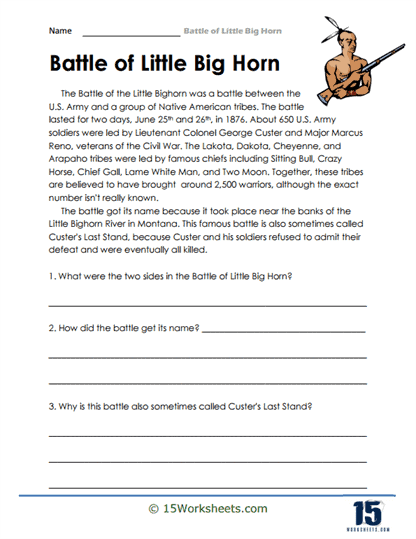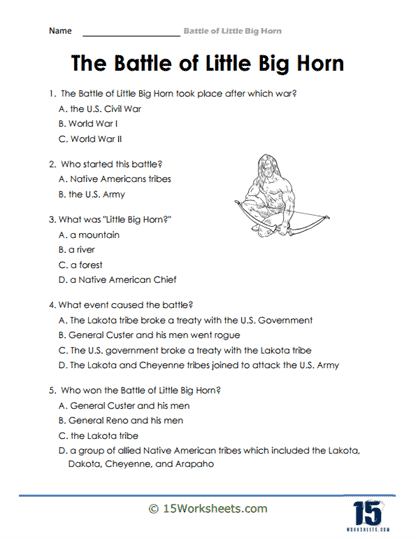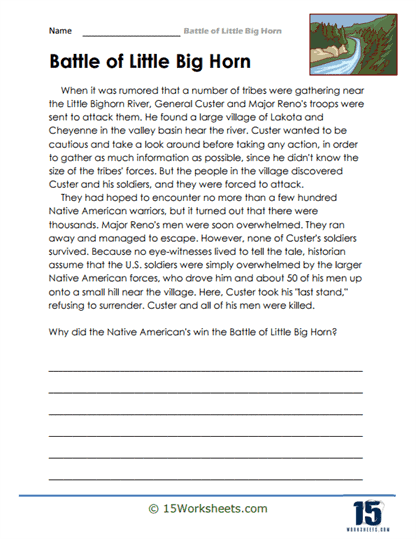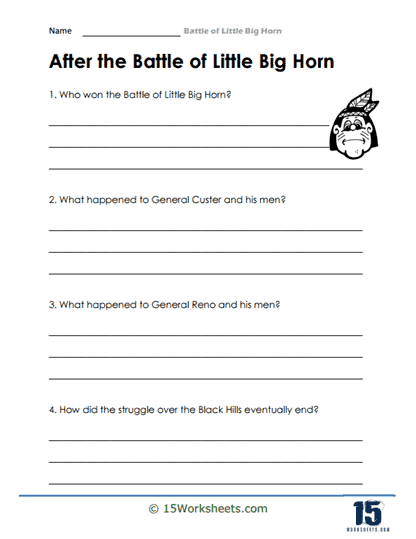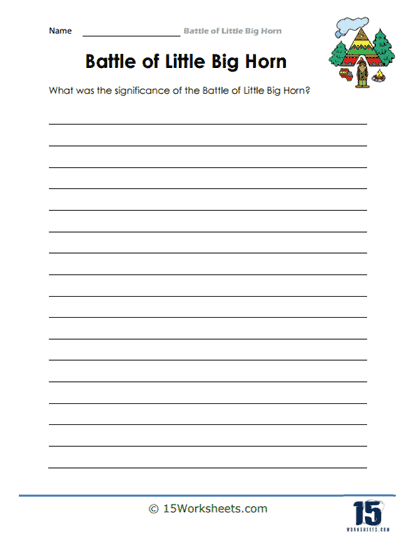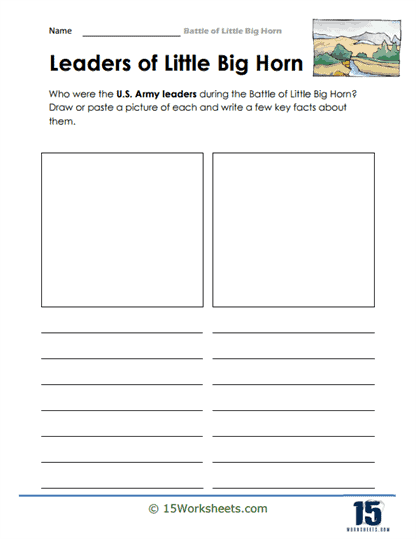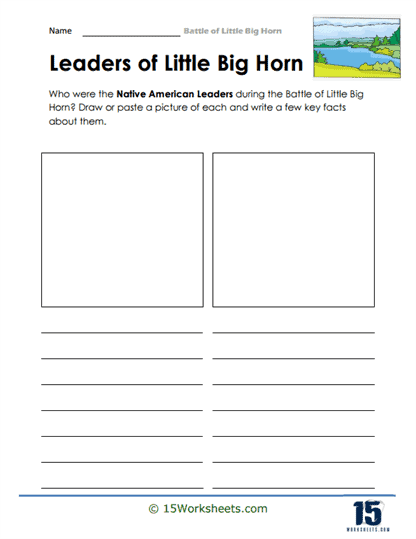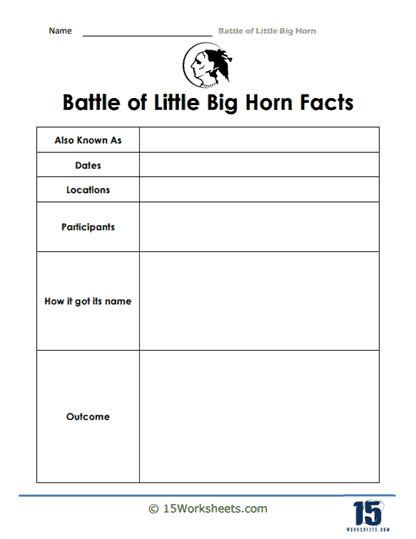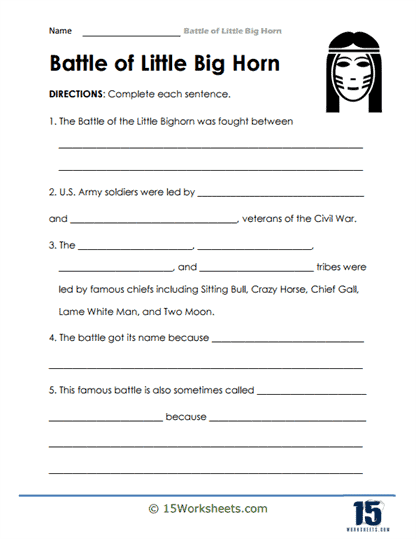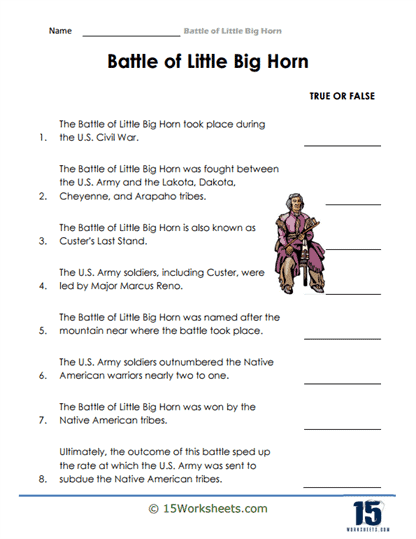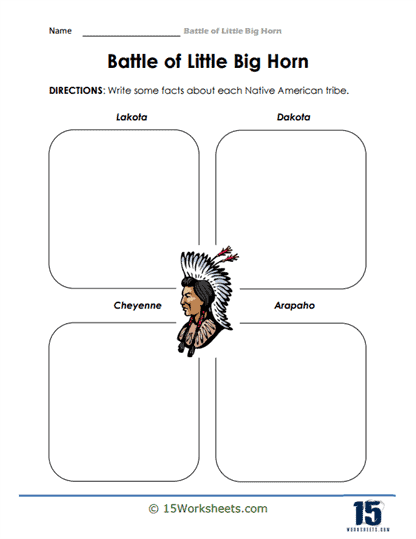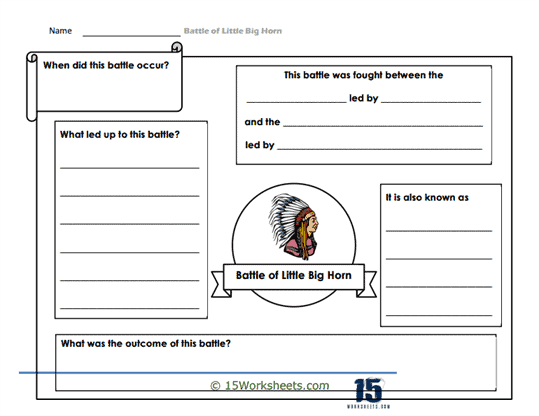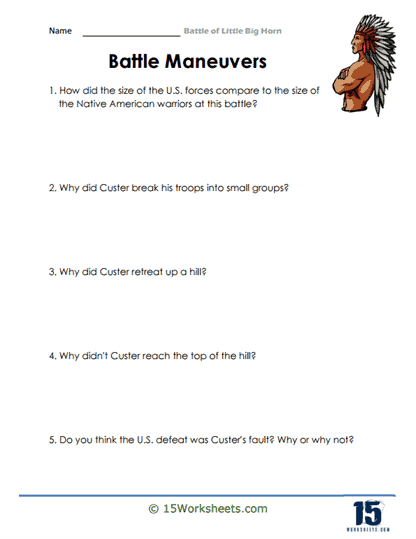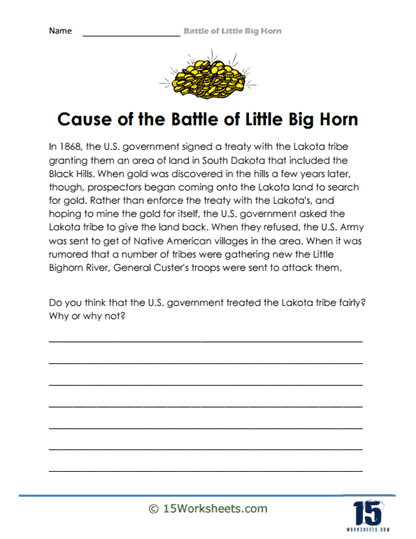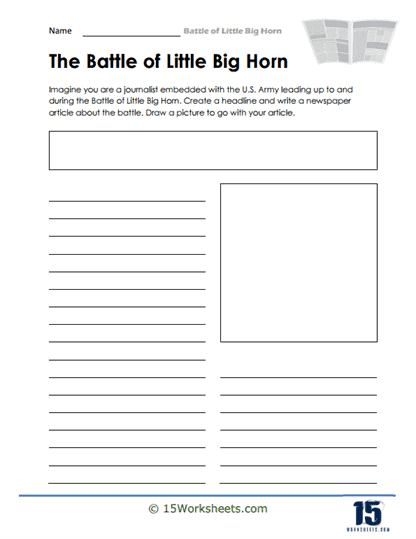Battle of Little Big Horn Worksheets
All About These 15 Worksheets
Students embark on a gripping exploration of the Battle of Little Bighorn with this comprehensive series of 15 worksheets. This collection is designed to transport students back in time to one of the most significant conflicts between the U.S. Army and Native American tribes in American history. Through engaging activities and thought-provoking exercises, students will gain a deeper understanding of the events leading up to the battle, the key players involved, and the lasting impact of this historic event. Through these worksheets, students will:
- Immerse in assigned passages that recount the events of the Battle of Little Bighorn and critically analyze the material and reflect on its historical significance by answering comprehension questions;
- Recall key facts and events related to the battle through multiple choice questions, fostering a deeper understanding of the topic;
- Engage in reflective and analytical writing with thought-provoking prompts to express their insights, interpretations, and perspectives on various aspects of the conflict;
- Research and write key facts about the prominent leaders involved in the Battle of Little Bighorn;
- Create infographics that showcase key facts and details about the Battle of Little Bighorn;
- Evaluate statements related to the Battle of Little Bighorn and determine their accuracy;
- And create a news headline and write an article about the Battle of Little Bighorn to capture the essence of the event and practice journalistic writing in a creative way.
Engaging with this series of worksheets will transport students to the dramatic events of the Battle of Little Bighorn, fostering a deep understanding of its historical significance, the key players involved, and its lasting impact. Through various activities and thought-provoking exercises, students will develop critical thinking skills, empathy, and a greater appreciation for the complexities of this important moment in American history.
What Was the Battle of Little Bighorn?
The Battle of Little Bighorn was a major conflict between the United States Army and Native American tribes that took place on June 25-26, 1876, in Montana. The battle is also known as Custer’s Last Stand, as it resulted in the defeat and death of General George Armstrong Custer and many of his troops.
At the time of the battle, tensions were high between the US government and Native American tribes who were resisting efforts to force them onto reservations. Custer and his troops, who were part of the Seventh Cavalry, were sent to confront the Lakota Sioux, Cheyenne, and Arapaho tribes who were gathering in large numbers in defiance of US government orders.
Custer divided his troops into three groups and attempted to launch a surprise attack on the Native American encampment. However, he underestimated the strength and skill of the tribes, who were led by chiefs Sitting Bull and Crazy Horse. The Native Americans quickly counterattacked, surrounding and overwhelming Custer’s troops.
In the end, Custer and his entire command were killed, along with many of their supporting troops. The battle was a significant victory for the Native American tribes, who were able to repel the US military’s efforts to suppress them.
The Battle of Little Bighorn is important for several reasons. It was a major event in the ongoing conflict between the US government and Native American tribes, and it highlighted the power and resilience of Native American resistance. It also marked the end of Custer’s military career and became a symbol of heroic sacrifice in American popular culture. However, the battle also had devastating consequences for the Native American tribes involved, as the US government responded to the defeat with increased military force and repression.
Key Leaders in the Battle of Little Bighorn
The Battle of Little Bighorn, also known as Custer’s Last Stand, involved key leaders from both the U.S. Army and the Native American tribes. Here are the notable leaders on each side:
U.S. Army Leaders
- Lieutenant Colonel George Armstrong Custer: Custer was a renowned cavalry officer and commander of the 7th Cavalry Regiment. He led the U.S. forces during the battle and made the fateful decision to divide his troops into three separate columns, underestimating the size and strength of the Native American encampment.
- Major Marcus Reno: Reno was a U.S. Army officer who commanded one of the three columns during the battle. He initiated the initial attack on the Native American encampment but faced heavy resistance, eventually retreating and taking a defensive position on a nearby hill.
- Captain Frederick Benteen: Benteen was another U.S. Army officer who commanded a column of troops. He played a crucial role in supporting Reno’s forces and reinforcing their position during the intense fighting.
Native American Leaders
- Crazy Horse: Crazy Horse, an Oglala Lakota warrior, was one of the key leaders of the Native American forces. He demonstrated exceptional skill in battle and was highly respected for his bravery and military tactics. Crazy Horse played a pivotal role in coordinating the defense of the Native American encampment and leading counterattacks against the U.S. Army.
- Sitting Bull: Sitting Bull, a Hunkpapa Lakota leader, was a prominent spiritual figure and inspirational leader during the battle. While he did not engage in direct combat, his spiritual guidance and influence bolstered the morale of the Native American warriors.
- Gall: Gall, a Hunkpapa Lakota warrior and leader, fought alongside Crazy Horse in defending the encampments. He demonstrated great bravery and leadership during the battle, inspiring his fellow warriors.
These leaders on both sides played crucial roles in the Battle of Little Bighorn. Their decisions, strategies, and actions shaped the outcome of the conflict. The battle marked a significant event in the history of Native American resistance against westward expansion and remains a subject of study and interpretation to this day.

